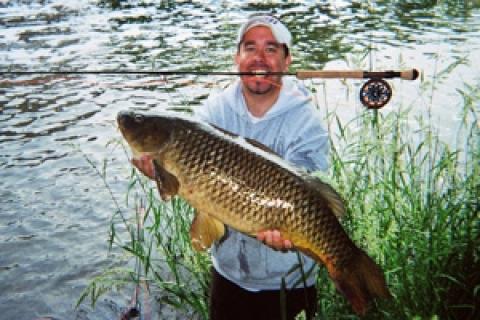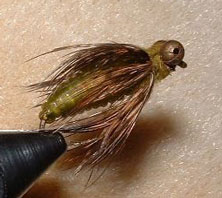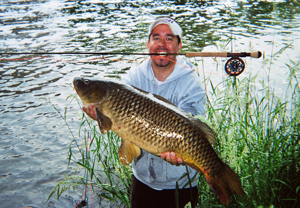
Every year, as the spring flows slowly settle out of our favorite bodies of water, you'll find dozens of anglers fighting for river real-estate in hopes of catching a few early-season trout. As fun as it is to have a nice trout or two stretch your fly line, there is a migration of fish every spring that can't be topped when it comes to sheer numbers of fish, spirit and overall fighting ability — the carp.
For some reason, most fly fisherman never tap into the wealth that carp have to offer. No other game fish in the Midwest offers such a distinctive fly-fishing experience. Even the most experienced fly anglers will find fooling these keen-eyed fish a challenge. Couple this to their size, abundance and general lack of fishing pressure, and carp may just become the fly-rod game fish you've been looking for.
Equipment Considerations
If you're already a fly angler, fly fishing for carp shouldn't require any new or specialized tackle. Heavier, longer rods make fighting these powerful fish easier, but just about any fly rod. should do. Ideally, though, 7- or 8-weight 9-1/2-foot rods will allow anglers to fight fish aggressively while 5- or 6-weight 9-foot rods will allow anglers to softly present flies to fish. Of course, your fly reel should match the weight of the rod you're using, and it should be equipped with a very good drag system.
Carp are big, strong fish that make multiple runs through the course of the fight. Having a quality reel that can pick up line quickly and regulate line going out will definitely payoff with more fish on shore. It's also a good idea to check your line connections and your backing before going out carp fishing. Fighting a large carp into your backing is no time to realize that one of your knots is not as strong as you thought.
Weight forward fly lines are the standard when chasing carp with a fly rod. These lines allow you to target fish at any depth while never entering the fish's field of view as they forage along the bottom.
Leaders used for carp should be tough enough to stand up to the repeated long runs these fish dish out. Nine to 12-foot, 1x and 2x leaders are choice for this type of fishing as carp generally are not leader shy. If fish are being spooked, however, 12-foot leaders in the 3x to 4x range can be used if you're cautious not to press hard on the fish once you're hooked up.
Flies
 |
| Carrying a wide variety of small nymphs, such as the Dragon Fly nymph shown here, will keep even finicky fish biting. |
Carp are not discriminating when it comes to diet. If it's in their path and looks edible, it's going down. In most cases, the easiest fish to target are those on or near bottom, so using various nymph patterns is usually your best choice. Nymphs in sizes 6 through 12 are the most common patterns. Smaller flies will be better for clearer water conditions, while larger patterns work best in muddier situations.
Where I fish, light-colored patterns seem to work better for carp, although darker patterns still produce. Ideal flies should be weighted so that they drop quickly to the bottom where these fish feed. But flies shouldn't be too heavy; heavily-weighted beadhead patterns are generally not a good idea as they create a little more splash on their entry into the water.
Pheasant tails, dragonfly nymphs, scuds, Hares Ears and weighted wooly worms are all regularly used for carp. If you are on new waters, your best bet is to check what aquatic invertebrates are residing in the river or lake you plan on fish, and then match your flies to the real thing.
Targeting Carp
If you've ever fished for carp or spent time searching the shallows, you've probably noticed typical carp behavior — dozens of fish grouped together, playfully jumping, nudging and following each other around. Although these carp deserve a cast to two, these fish are not actively feeding and will be difficult to get to bite down.
The carp you should be targeting will display a more solitude behavior and will be found tailing or rooting around on the bottom. These fish are actively searching for food, which places them at the top of your list of possible targets to cast too. Finding these feeding carp is not for the faint hearted; in most cases, fly anglers will need to do some extensive walking with a sharp eye.
If you're lucky enough to come across a few actively feeding carp, don't be too hurried to cast in the general direction of the fish. In most cases, feeding fish will be slowly moving, so taking a second or two to figure out the best place cast will only help to increase your odds of getting the fish to bite. In most cases, carp will not charge out and aggressively take a fly, so accurately placing your fly in the path of the fish is a must.
With that said, current, wind and the carp's movements will make precise casting difficult. A good technique is to try casting out in front of your target carp, and then quickly pull the fly back to where the fish can see the fly. If possible, getting your fly to sink slowly in the fish's strike zone will produce the best results. 
If you happen to cast toward a fish and it spooks (and they will), don't chase the fish. Just let them swim slowly away. Sometimes these spooked fish will start rooting around again giving you a second shot at casting to them. Chasing a spooked fish will only cause them to swim away wildly, potentially scaring away other cast-worthy carp.
On the other hand, if the cast you've made does not hit the spot, don't just let it sit there hoping for the carp to come over and investigate. Slowly strip the fly away from the fish's respective area, then pick up the fly line and try again. If you do get a good cast and your fly lands close to the feeding carp, move it very little if at all. Having the fly scoot across the bottom or bounce up and down will either spook the carp or take it out of the carp's range.
Once you've gotten the hang of finding feeding carp and presenting flies in a reasonably discreet manner, the next hurdle to jump is figuring out whether a fish has actually taken your fly or not. For many fly-fishing beginners, nymphing for trout and other species can present problems when trying to detect strikes. Carp are no different. Their large size, habitat and feeding behaviors make it very hard for the inexperienced angler to figure out if a bite has occurred.
As a carp nears your fly, watch for any cues that he may give you. Dipping of the head, flaring of the gills and fins, or sitting motionless after digging on the bottom are all subtle clues that the carp has picked up your fly. If you suspect that a carp has inhaled your fly, slowly tighten your line and feel for any weight on the end of your line.
Additionally, keeping a keen eye on your leader will tell if a fish has taken your fly. A small twitch or a slow migration of your leader in the water can be a good indicator a carp has bitten down. Don't ever be afraid to check to see if a fish is on the line. Many carp fisherman miss the majority of the fish they are targeting simply due to the fact that they miss the strikes from fish.
Carp can be found as early as March, giving fly anglers an alternative to heavily sought-after game fish. So get out and explore your favorite body of water; you may have never known these brutes swam so close to home. Bring a friend and a camera, and be prepared to have a great time this spring taking a few carp on the fly!
- 9004 views

